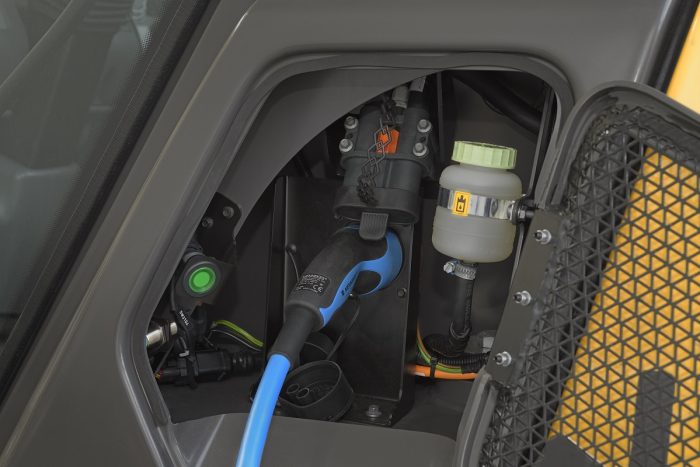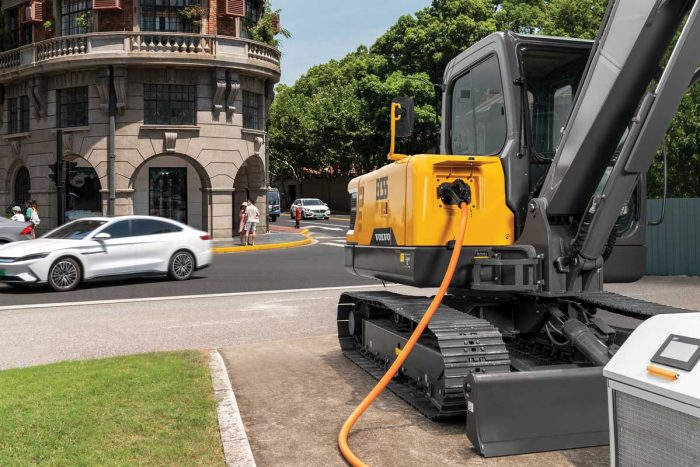What New Maintenance Items Are Important for the Upkeep of Electric Construction Equipment?

As emissions regulations and reduction goals continue gaining traction, contractors need options to help them meet these directives. Equipment that offers equal power and productivity with lower emissions and noise — like battery-electric equipment — is a huge step in the right direction. Electric machines are certainly becoming more common, and many technicians are curious about maintaining them. So, how different is maintenance for electric construction equipment with lithium-ion batteries compared to diesel equivalents? The short answer is that it’s much simpler — hardly any maintenance is needed on the electric components, and I have heard directly from users who are quite impressed by and happy about this. But if you’re looking for a little more detail, keep reading.
Built-In Convenience

One major advantage of electric equipment is that it shuts off when not in use, so it’s not racking up idle hours like a diesel machine that needs to keep fuel and fluids moving. As a bonus, this can help reduce the total cost of ownership and improve resale value. Because there is no engine or fuel system, it makes sense that filters and DEF are not needed on electric equipment. Essentially, the only supplies required are hydraulic oil and grease, which is much different than a conventional machine that requires fluid, filter and component checks as often as every day, with additional cyclical preventive fluid and filter maintenance.
There is no difference in the maintenance of non-electric components like hydraulic pumps and hoses. However, prior to performing any maintenance on the non-electrical components or systems, the same risk assessment process must occur as is performed for work on the electrical components. Even though the work may not directly involve the electrical or battery power systems, there may still be inherent risk. Which leads us to …
Training for Safety

Electric components like the lithium-ion battery, AC to DC power converter, inverter, battery management unit and charging plug just need visual and functional inspections. Any components that are not working would be replaced, not repaired.
When diagnostics reveal a need for component removal or other maintenance, a risk assessment must be performed by a qualified technician, and the traction voltage system must be disconnected and “decommissioned.” This should only be performed by individuals who have completed a thorough certified training program.
Because we’re talking about machines using electricity, most of the needed training will be about safety. Some of the concepts that are important to learn include how an AC three-phase motor functions, Ohm’s law (the relationship between voltage, current and resistance in a circuit), Fleming’s left- and right-hand motor and generator rules and the effect that current flow has on a magnetic field. Other topics unique to electric machines are inverter function, onboard charging system operation and how a lithium-ion battery works (see sidebar).
This may sound like a big shift in what technicians need to know, but it’s part of our ever-evolving industry. It’s just like when telematics and in-cab displays started becoming more prominent — technicians had to learn how to service those. When you consider the complexity of internal combustion engines, the differences between diesel and gasoline engines, differences between two- or four-stroke engines and the fact that engines have an average of 2,000 moving parts, perhaps electric machines don’t seem so complicated.
Proper charging is also important. Check out these videos.
A Valuable Shift
Overall, the lifetime of battery-electric components should be equal to or better than that of the diesel engine on a conventional machine. Volvo conservatively estimates that users will see a 35 percent savings in maintenance costs and time over the life of the machines it offers. And warranties for electric components can provide extra peace of mind. Though the shift to electric requires some training, the maintenance needed for these machines is much simpler and less frequent. With electrification expected to grow exponentially in the coming years, it’s a worthwhile investment of technicians’ time.
Lars Arnold is product manager of sustainable power at Volvo Construction Equipment.
Understanding Lithium-Ion Batteries
Obviously, the lithium-ion (or li-ion) battery inside an electric machine is a significant component of its operation and success. While there isn’t much to “maintain” regarding the battery, it’s helpful for technicians and operators to understand how the battery works so they can safely handle it and use it. Lithium-ion batteries are rechargeable batteries also used in devices such as cell phones and laptops. They’re named for the lithium ions that move between two electrodes during the charging and discharging cycles to store and release energy.
Li-Ion Battery Anatomy
First things first: Electricity cannot be captured and stored. It must be converted to another energy form (e.g., chemical energy) which can then be stored. In an internal combustion engine, the bond energies within gasoline or diesel molecules are broken and converted to heat, which transforms into the mechanical energy needed to drive the piston. Similarly, batteries store electricity from the power grid in the form of chemical potential and then discharge energy to provide electricity when needed.
Lithium-ion batteries contain four main components:
- Anode (-), Cathode (+), Separator, Electrolyte
A battery must be connected to an external circuit to absorb and release energy. Electrons move through the external circuit while lithium ions move through the electrolyte. So, what are anodes, cathodes, separators and electrolytes?
Anodes (the negative end) store and release lithium ions from the cathode during charging (conversely, they release lithium ions during discharge). They’re typically made of graphite.
Cathodes (the positive end) serve as the origin of lithium ions, playing a crucial role in determining the battery’s capacity and nominal voltage. They’re typically made of active material, e.g., NMC (nickel, manganese and cobalt), NCA (nickel, cobalt and aluminum) or LFP (lithium, iron and phosphate).
The separator divides the anode and cathode and prevents direct contact between them.
The electrolyte provides lithium-ion conductivity. It’s a chemical solution that transports lithium ions and prevents the electrons from going straight from the anode to the cathode within the battery.
How the Battery Works
Let’s take the current widespread adoption of lithium-ion chemistries, NMC, as an example:
- During charging, electrons accumulate at the anode (electricity is converted into chemical potential).
- This results in an electrical difference between the anode and the cathode. Think of this as an unstable buildup of the electrons.
- The oppositely charged lithium ions move inside the battery from the cathode through the electrolyte to balance the charge.
- While the battery is discharging, the anode releases lithium ions to the cathode, generating a flow of electrons from one side to the other. It converts the stored chemical potential energy to electricity in the circuit and discharges the battery.
While this may still seem a bit complicated, that’s mainly because it’s new to our industry. With time and experience, it will all start to make more sense.
